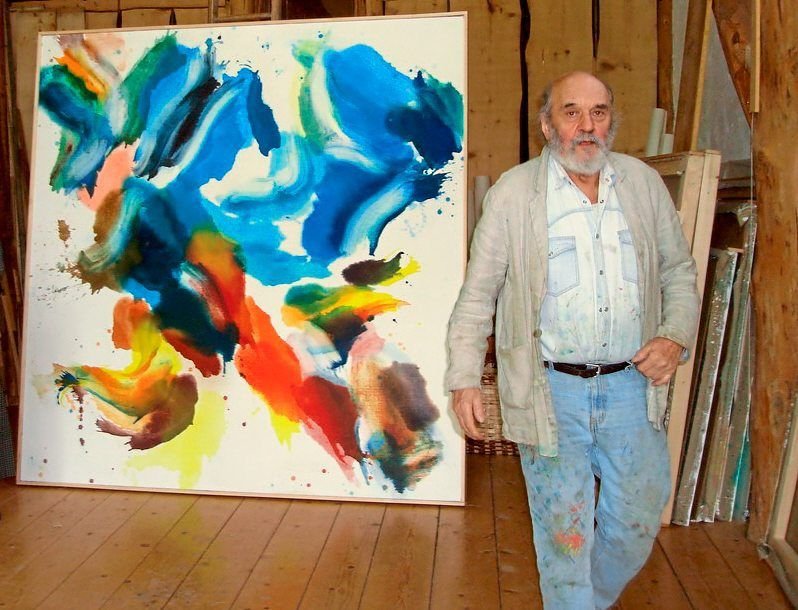The Academy mourns the death of Wolfgang Hollegha (1929 - 2023)
From 1972 to 1997, Wolfgang Hollegha was professor at the Academy of Fine Arts, where he last taught a masterclass in painting.
Wolfgang Hollegha was born in Klagenfurt on 4 March 1929. His father had died before he was born and his mother soon after. He grew up with his mother's sister in Frohnleiten, Styria - very close to his long-time home on the Rechberg. After graduating from high school in Graz, he attended the Academy of Fine Arts in Vienna from 1947 to 1954, studied in Josef Dobrowsky's masterclass and became friends with Josef Mikl. Together with Markus Prachensky and Arnulf Rainer, the two founded the "St Stephan's Painters' Group" in 1956 around the churchman and art lover Monsignor Otto Mauer, which was to lead the triumphant advance of expressive abstraction in Austria.
The opportunity for international fame quickly presented itself: in 1958 Hollegha was awarded the Guggenheim Prize, and in 1959 he was discovered by the New York art critic Clement Greenberg, who invited him to a group exhibition with the stars of abstract painting such as Morris Louis, Barnett Newman, Kenneth Noland and David Smith. In 1960, Greenberg also invited the young Austrian to a solo exhibition in New York. Hollegha exhibited twice, in 1964 and 1966, at the Guggenheim Museum. Despite these successes, the artist decided not to stay in New York, then the centre of modern painting, but returned to Austria, bought his 400-year-old farm on the Rechberg and began building his 14-metre-high summer studio tower in seclusion.
In 1961, Hollegha was honoured with the Carnegie Prize Pittsburgh, and in 1964 he presented his work at the "documenta III" in Kassel. The following year he received the Körner Prize, followed by the Joanneum Art Prize of the Province of Styria in 1967, and in 1990 the artist was awarded the Gold Medal of Honour of the Federal Capital of Vienna. At the age of 90, he was honoured with the Grand Decoration of Honour in Gold of the Province of Styria.
From 1972 to 1997, Hollegha was a professor at the Academy of Fine Arts, where he last taught a masterclass in painting. He retired together with Arik Brauer, Friedensreich Hundertwasser, Anton Lehmden and Josef Mikl. Hollegha's paintings can be found in numerous Austrian museums today - such as the Albertina, the Belvedere and the mumok.
Representatives of Austrian politics reacted with sadness to Hollegha's passing. "Without the work of Wolfgang Hollegha, Austrian art history would have been written differently. Not only did he celebrate significant successes very early on in the context of abstract expressionism, but he also chose Austria as his place of work - despite an early, steep international career - and thus made our art and culture nation shine in a way that remains unique," said State Secretary for Culture Andrea Mayer (Greens) in a statement honouring the deceased.
The Governor of Carinthia, Peter Kaiser (SPÖ), spoke of an "extraordinary loss": "Wolfgang Hollegha was an exceptional artist who left traces during his lifetime that will remain visible far beyond his death." Vienna's City Councillor for Culture Veronica Kaup-Hasler (SPÖ) paid tribute to an "artist of international stature who unswervingly pursued his ideas" and who will go down in art history as an Austrian avant-gardist. "With Wolfgang Hollegha, Styria is losing a great artist. Independent of art fashions, he developed his very own way of painting, his own unique style. His approach to nature was particularly important to him. He understood in an inimitable way how to transfer what he saw and felt onto the canvas," condoled Styrian Governor Christopher Drexler (ÖVP). His predecessor in office, Hermann Schützenhöfer (ÖVP), also expressed his sadness: "I was always an admirer of Wolfgang Hollegha. His paintings remain almost unrivalled in their form of expression."
Übersetzt von APA, 04.12.2023
https://apa.at/news/maler-wolfgang-hollegha-mit-94-jahren-gestorben-3/
